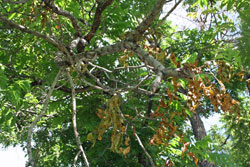Walnut twig beetles (Pityophthorus juglandis) make thousands of boring holes in branches and trunks. They carry the canker-producing fungus (Geosmithia sp.) that affects more and more wood as insect attack continues. The first symptom is leaf yellowing and flagging particularly in the upper crown. Leaves eventually dry and remain on trees for an extended period.
Progressive dieback over time kills or affects larger limbs and ultimately the entire tree within two to three years of first symptoms. Cankers within the tree are rarely visible on the bark exterior. Have trees examined at the first sign of TCD symptoms and remove diseased trees promptly according to applicable city tree regulations.
This disease is primarily an urban forestry issue in Colorado because there are no native stands of black walnuts. Although there is much shade and other landscape value at risk in Colorado’s cities and towns, the stakes are higher in states to the east. Missouri estimates a potential loss of $850 million in wood and nut production if TCD reaches the native walnut forests of the eastern United States. Potential ecological impacts are as yet unknown.
At present there are no known chemical or other treatments. The first concern is preventing further spread of the disease. The logs and branches of removed trees should be destroyed to prevent disease spread. Do not transport walnut wood or chips particularly to the east. Missouri, Kansas, Nebraska and Michigan have placed quarantines on unprocessed walnut wood from the western U.S.
See the CSU Pest Alert for photos and more information at: http://extension.colostate.edu/docs/pubs/insect/0812_alert.pdf



